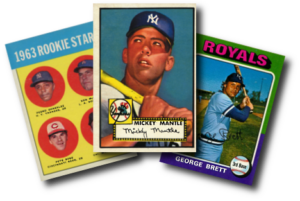What Are Sports Cards and Why Is the Market Booming?
Sports cards, often referred to as trading cards, are collectible items featuring athletes from various sports like baseball, basketball, football, and hockey. These cards typically display the athlete’s image, stats, and other details on one side, with some including unique features like autographs or game-used memorabilia. Once just a pastime for kids, sports cards have evolved into a thriving market, blending nostalgia with serious investment opportunities.
A Brief History of Sports Cards
The sports card hobby dates back to the late 1800s when tobacco companies included cards in cigarette packs to promote sales. Over the decades, companies like Topps, Panini, and Upper Deck turned sports cards into a standalone industry. From vintage gems like the 1952 Mickey Mantle card to modern-day Rookie Cards, collectors have sought these treasures for their historical significance and potential value.
The hobby experienced its first major boom in the late 1980s and early 1990s, followed by a decline due to market oversaturation. However, the COVID-19 pandemic sparked a resurgence as people revisited hobbies and sought tangible investments. The global sports card market, valued at approximately $10.18 billion in 2023, is projected to grow to nearly $40 billion by 2031 .

Why Are Sports Cards So Popular Today?
Several factors contribute to the modern-day popularity of sports cards:
- Grading and Authentication: Professional grading services like PSA and Beckett authenticate and assign a grade to cards based on their condition. Graded cards command higher resale value, providing collectors and investors with confidence in their purchases.
- Rarity and Exclusivity: Card companies now produce limited-edition cards, including Parallels, Case Hits, and Autographs, driving demand among collectors looking for unique items.
- Investment Potential: Many view sports cards as alternative investments, akin to stocks or real estate. Cards of legendary players like Michael Jordan or Tom Brady have sold for millions of dollars at auction .
- Community Engagement: Platforms like Instagram and YouTube allow collectors to share their collections, participate in live breaks, and stay connected with the hobby.
What Does the Market Look Like Now?
The sports card market has shifted from mass production to a focus on scarcity and innovation. Companies like Fanatics, which recently acquired Topps, are poised to revolutionize the hobby by introducing direct-to-consumer models and exclusive licensing deals .
Grading services have also become central to the market. For instance, PSA graded over 10 million cards in 2022, reflecting the demand for authenticated collectibles. Meanwhile, trends like group submissions make grading more accessible by lowering costs and simplifying the process.
How to Start Your Sports Card Journey
If you’re new to sports cards, begin by identifying your interests—whether it’s vintage cards, modern rookies, or rare inserts. Consider grading high-value cards to protect and enhance their worth. Platforms like eBay and PWCC are great places to buy, sell, and research card values.
For those looking to streamline the grading process, group submission services can help you navigate costs and logistics while ensuring your cards are handled professionally.
Final Thoughts
The sports card market is more vibrant than ever, offering endless opportunities for collectors and investors alike. Whether driven by nostalgia, a love for sports, or investment potential, the hobby continues to evolve, blending tradition with modern innovation.
Ready to dive in? Explore resources like PSA, Beckett, and eBay to start building your collection today. Also, check out our shop by clicking here.
